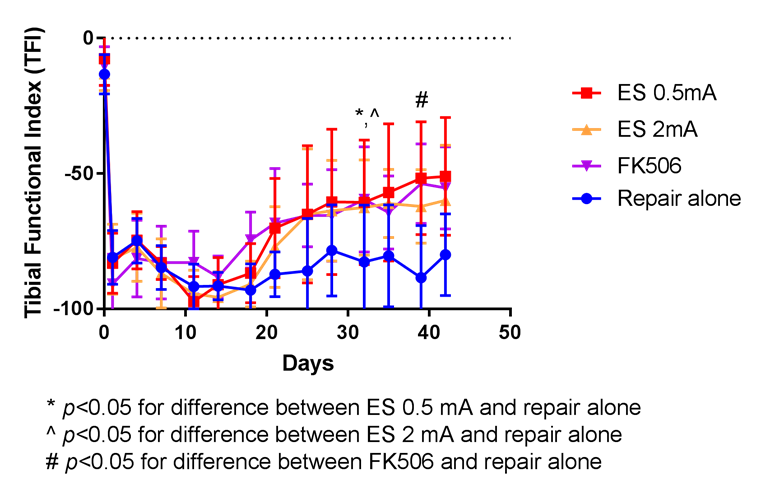Intra-Operative Electrical Stimulation Using a Commercial Stimulator Improves Functional Recovery after Peripheral Nerve Injury in Rats
Sally Jo, BS; Deng Pan, BS; Alexandra E Halevi, MD; Xueping Ee, MD; Daniel A. Hunter, RA1; Lauren Schellhardt, BS; Alison K. Snyder-Warwick, MD; Amy M. Moore, MD; Susan E. Mackinnon, MD; Matthew Wood, PhD
Washington University School of Medicine, St Louis, MO
Background: While electrical stimulation (ES) has shown promise to improve the management of nerve injuries, an approved, clinically available device to implement these findings is needed. We evaluated whether a commercially available intra-operative stimulator could be utilized to provide therapeutic ES directly to nerve following surgical repair. We hypothesized that nerve repair with ES would promote regeneration and functional recovery more quickly than nerve repair alone in a rat nerve transection-repair model.
Methods: Male Lewis rats were randomized to four experimental groups: "ES 0.5mA," "ES 2mA," "FK506" as a positive control, and "Repair alone" as a negative control. All groups underwent tibial nerve transection and immediate repair. ES at either 0.5mA or 2mA was delivered intra-operatively for 1 hour following nerve coaptation. FK506 was administered daily, starting 3 days prior to injury and continuing after nerve repair to maximize its beneficial regeneration effect. Walking track analyses were performed biweekly until six weeks postoperatively, obtaining the tibial functional index (TFI) to measure recovery of motor function. Cold allodynia testing and relative muscle mass analyses were performed at this experimental endpoint. In a second cohort, nerve histomorphometry distal to the repair was assessed at postoperative day 21.
Results: Motor recovery, as measured by significant improvement in TFI compared to the repair alone group, occurred by day 32 in the ES 0.5mA and ES 2mA groups (p<0.05) (Figure 1). In the FK506 group, TFI recovered by day 39 (p<0.05). On histological analysis, the total number of nerves, percent area of nerves, and nerve density were significantly greater in the ES 0.5mA and FK506 groups (p<0.05) compared to repair alone. Increased relative muscle mass was only observed in the FK506 group compared to the repair alone group. No differences were found among the groups in terms of cold allodynia responses.
Conclusions: Intra-operative ES of repaired nerve using a commercial intra-operative stimulator improved motor recovery and nerve regeneration in rats, demonstrating potential for further clinical evaluation.
Figure 1. Motor recovery serially tracked using walking track analysis. From walking tracks, the tibial functional index (TFI) was calculated to compare groups. Both electrical stimulation (ES) groups, delivering current at 0.5mA and 2mA, showed improved TFI compared to Repair alone by day 32, while the FK506 group showed improved TFI compared to Repair alone by day 39.
Back to 2019 Absteracts
